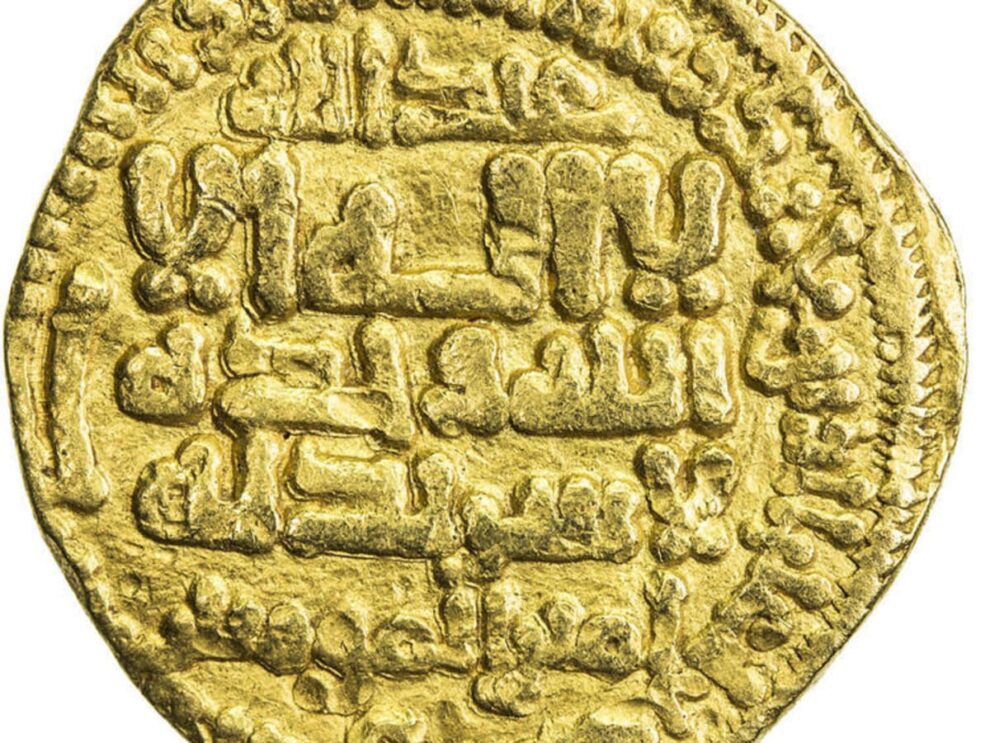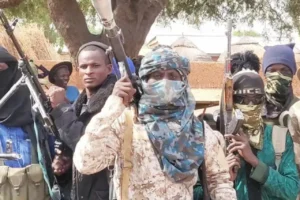My bird’s eye survey of the 10th century tells me that several political entities declined or fell at the start, while at the end things were still in flux in many parts of the world. Over 100 years the Tang dynasty fell, and the Song dynasty rose in China. England became a united country. The Vikings were marauding from Ireland to Russia. Poland became Christian. The Tonga Empire was established. The Maya Empire in Central America declined, the Toltecs in Mexico grew. In Pakistan the Hindushahi Turks were conquered by Arabs from the west. The Arabs were in Spain too, and Sicily. Iran was becoming an Islamic cultural center. The Byzantine Empire was, for the most part, stable.
The historical record is somewhat fragmentary for most of Africa in that century. We “civilized” people like to see “cities” to think that the culture we’re looking at is “important.” Governing structures are all about the same, though, at any level, I suppose. Someone is in charge, or people are arguing about who it is. The people in charge must deal with other people who are in charge of other groups of people. Same for family units in the bush, or nomad hordes, or kings with armies. Plenty of slaves were coming out of Africa. That had been going on since Egyptian times. They came north by caravan across the Sahara Desert and were sold into the Mediterranean and Middle Eastern markets. Some of them were traded all the way to India.
At the start of the 10th century, in Tunisia, the dynasty of Aghlabid governors had been diminished by circumstances, and there was a decline in morale, as it were. In Islam there has been a tendency for political rebellion to present in the mode of restoration of the classical religious values. The precise shape of the values can vary. North Africa was swept by the Fatimid movement, which got its start in Tunisia. I should briefly describe the situation that gave rise to the Shia and Sunni branches of Islam.
Muhammad died and did not name a successor to either of his social roles: spiritual leader, and political ruler of his co-religionists. A council consisting of mostly his adult male relatives, a few females, a few outsiders, met, and, after extensive argument, decided that there would only be one prophet (there were claimants to that title out there, including some women), and that there would be a “Commander of the Faithful,” who should be a member of Muhammad’s family. They would call that person “Khalifa,” meaning, among other things, “successor,” and which we anglicize as “Caliph.”
Ali, a cousin and son-in-law of Muhammad, was put forward to be the first Caliph, but another person maneuvered into the spot. After that one came another, who conquered Persia, and was assassinated. The third Caliph was nepotic and incompetent. Factions developed for and against him. There was another assassination. Ali became the fourth Caliph. Ali was immediately faced with two opponents in the Community of the Muslims. There was a group in Mecca that wanted to elect the Caliph by a new council, and a general, Mu’awiya, in Syria, who had been loyal to the third Caliph. War developed and Ali was killed in battle.
Adherents of the slain Ali at that point refused to accept the new Caliph, Mu’awiya, the general, and went into a separation that has lasted until this day. They set up a different line of religious leadership succession. Those are the Shia. One branch of their doctrine is big in Iran these days. Most of the rest of the Muslims are Sunni, who followed the line of the Caliphs. The Shia and the Sunni pray differently and think about some things differently. They all are Muslims though.
The Shia were active in Iran back then, too. And they sent out missionaries. To Tunisia, as it happened, where Shia preachers put together the movement that in the 10th century conquered most of North Africa and the Levant. The leaders of that movement, when they took Egypt, started calling themselves Caliphs. We call their line the Fatimids. So, there were three Caliphs at that time. There were the Abbasids in Baghdad, and the Umayyads who had fled to Spain, and the Fatimids in Africa. Each claimed to be the only Caliph.
The Fatimids got started out in the countryside. The first city they took, Al-Mahdiyya, is in Tunisia. They struck coins there. Then they moved the capital to Al-Mansuriyya, near Kairouan, also in Tunisia, where they also struck coins, then in Kairouan itself. Then they moved to Egypt and founded Cairo, from which they built their empire. After some flourishing decades the Seljuk Turks appeared from the east and the Crusaders appeared from the north. The Fatimids faltered. Saladin, a Sunni and a Kurd, took up the defenses of the Faith.
The Fatimids had left most of North Africa by the middle of the 11th century, retreating to Egypt. Fatimid coins, as we find them, are mostly gold dinars of high fineness. There seem to have always been a lot of them around during my entire career in the market. Most are from Egypt. There are also silver dirhams and fractions. They began as full weight coins of high fineness, but after a few decades, the weight became variable, and the metal was debased. Variable weight coins are meant to be weighed in bulk, not counted. Billon coins always have ambiguous value, and there is some degree of fiat nature attached to their use. Billon needs inspectors to enforce their official value.
The dates and mints of the later coins are usually off the flans. Instead of copper, they used glass paste jetons, apparently all from Egypt. The Fatimids, when they moved to Egypt, left a governor named Ziri, who founded the Zirid dynasty. As governors, the Zirids expanded west to the Atlantic and east to the Egyptian border. They participated in the demise of the Umayyad Caliphate in Spain and messed around in Sicily a bit.
In the mid-11th century, the Zirids became Sunni and renounced their allegiance to the Fatimids. The Fatimids, unable to reconquer, allowed the Banu Hilal Bedouins of Arabia, who had been troublesome, to migrate through Egypt to North Africa, where they would be allowed to do their thing.
They were tough on the countryside. They killed peasants and stole stuff. Food got scarce. People fled to the cities. The economy declined. The Bedouins stayed around though, became part of the local power structure, had children, spread Arabic culture. For most of the dynasty the Zirid coinage named the Fatimid Caliph. Steve Album mentions some anonymous issues of the mid-11th century, identified by a non-Fatimid central legend on one side. Rare, of course. The Zirids started to fall apart from within. A branch of the family, the Hammadids, became autonomous in Algeria, and held Kairouan for a while. There are no Hammadid coins listed in Steve Album’s Checklist of Islamic Coins.
There are, however, a few coins listed for the Banu Hilal invaders sent by the Fatimids. Very rare. Anonymous. Another political entity showed up to harass the Zirids. The Vikings who had invaded northern France had settled down to become the Normans of Normandy. They settled, and became Christians, but they still liked to fight. One of them conquered England. Another conquered Sicily. Then, for a while, the Sicilian Normans conquered a slice of North Africa, specifically, the Tunisian coast.
The point man of that venture was Roger II, mid-12th century, in the general time frame of Saladin in the Levant, who did away with the Fatimid Caliphate and contended with the Crusaders. Roger’s idea was to raise up the remnant Christian population of Africa and bring back some version of the good old days. Seems, though, that there were not enough of them to do that.
Roger’s African Empire endured for a few decades, a few years into the reign of his successor, William I. There were a few Fatimid looking gold coins with Arabic legends struck by William I in Al-Mahdiya, a normal exercise of the medieval mint right, by which a conqueror claims a territory in writing that anyone who could read could read.
Meanwhile, over in the west, and a few decades earlier, another Islamic movement had arisen to attempt again to purify the Faith. That was the Almoravids. They were Sunni, Berber, built an empire in Morocco and Spain. They never quite got to Tunisia, though. The Almoravids, as political actors, evolved as almost all political movements do. They got settled in their ways, brittle, self-satisfied. Various kinds of corruption developed. They found themselves under pressure from yet another reformist movement, the Almohads.
The Almohads got their start in Morocco, same as the Almoravids. A charismatic leader gained followers, the Almoravid politicians neglected to snuff him out until the new guy became political, then martial, then there was war. Eventually the new movement won out, taking over the Almoravid Empire in Morocco and Spain, and later expanding eastward along the North African coast to the Egyptian border.
When the movement got established, the ruler had himself declared Caliph. Almohad coins are typically fine gold dinars and halves, nicely made, with fine calligraphy. There were also silver coins, mostly square dirhams to a reduced standard. Usually there is no mint name. There is never a date. The gold coins in general are not rare. The silver coins are generally common. Imitations of both the silver and the gold coins of the Almohads were made by Christians in Spain.
The Almohads had succession problems just like every other dynasty did. Outside observers took advantage. They split into Andalusian and African branches who fought with each other. Tunisia became a neglectable distant province to the Almohads. Governorships were always going hereditary. The governor of Gabes, son and grandson of previous governors, had his name declared in the Friday prayer as Amir. He then expanded his territory east and west. His efforts were aided by an influx of refugees from Christianizing Spain. Some of the immigrants had skills and/or money. We call this dynasty the Hafsids, after an ancestor of the first of the line.
The second Hafsid declared himself Caliph. Caliphs all over the place in those days. Tunis, the city, was favored, and grew to be the largest in the region. The Hafsid dynasty waxed and waned and waxed again. They were mainly involved in squabbles with their neighbors in Morocco. Egypt was in the hands of the Mamluks. Then they found themselves involved, as minor partners, in the conflict between Christians, with Spain the tip of the spear, and the Ottomans for control of the Mediterranean. The Ottomans took Tunis in 1534 and drove the Hafsid out. Carlos, King of Spain and Emperor of the Holy Roman Empire, took it and reinstalled the Hafsid as a formal vassal. The Ottomans came back, then again, the Europeans. This back and forth went on for several decades.
Finally, the Ottomans came to stay in 1574. They captured the Hafsid and sent him to Constantinople, where he was executed, any reason would do. The Ottoman Sultan then took the title of Caliph, which the descendants continued to hold to the end of the dynasty. Hafsid coins are mostly gold dinars, with some fractions, and a few silver coins. Tunis shows up rarely as a mint. The coins are undated. The earlier coins look like Almohad coins. The later coins are more Mamluk-like. They tend to be scarce and rare.
Source: NUMISMATIC NEWS
















